ANTH1150 Final Exam Review PDF

| Title | ANTH1150 Final Exam Review |
|---|---|
| Course | Introduction to Anthropology |
| Institution | University of Guelph |
| Pages | 13 |
| File Size | 161.5 KB |
| File Type | |
| Total Downloads | 191 |
| Total Views | 732 |
Summary
Unit 1: What is Anthropology?● Anthropology - Study of humanity, evolutionary origins and today's diversity, people and culture, literally means “study of man” ● Cultural Materialist Anthropologists - Emphasize material culture ● Symbolic/Interpretive Anthropologists - Focus on religious belief ...
Description
Unit 1: What is Anthropology? ● ● ● ● ● ● ● ● ●
● ● ●
●
● ●
●
Anthropology- Study of humanity, evolutionary origins and today's diversity, people and culture, literally means “study of man” Cultural Materialist Anthropologists - Emphasize material culture Symbolic/Interpretive Anthropologists - Focus on religious belief and symbolism in matters of identity as keys to understanding why we do what we do Culture - Constellation of learned values, beliefs and rules of conduct that members of a society share Ethnography - Writing an account of life in another culture Ethnology - Comparison and analysis of different cultures Holistic Perspective - Culture as an integrated whole with various features and patterns of which can only be understood in relation to one another Cultural Anthropology - Comparative study of living and recent cultures. Use ethnographic fieldwork and the perspective of cultural relativism Linguistic Anthropology - Study language in it’s cultural and historical context. Study of indigenous peoples, language change and relationship between language and culture, thought and belief Archeology - study of past cultures. Use written records and prehistoric cultures whose lives can be inferred from material artifacts, settlement patterns and remains of food and tools. Biological Anthropology - Study human origins using fossil record to understand human evolution, some study biological diversity in contemporary human populations Applied Anthropology - intersects with and draws from all the major sub disciplines in anthropology to study and solve contemporary problems in communities, governments and business Unit 2: Nature of Culture People acquire elements of culture in the context of their interactions with others. As members of families, social groups and communities people learn what kinds of behaviours are considered appropriate and inappropriate. Any culture that has a stable adaptation to its environment or ecosystem that works is just as successful as any modern industrial culture. Our own success through the agricultural revolution and industrialization may in fact only be a temporary phase in human history if we have indeed sown the seeds of our own destruction. Things like conflict, overpopulation, environmental degradation, global warming and a dependence on fossil fuel may act as self terminating factors in our long term prospects. Key components of culture influenced by E.B. Tyler 1871: ○ Behaviours + Beliefs - These are shared within a culture, if this was not the case people would not be able to achieve common goals. Obviously remember that race, age, gender and social status can create differences in people's lives. ○ Learned - Culture is not instinctual, even when people must fulfill critical physical and social needs, their cultures influence how they must satisfy those needs, it feels natural because our enculturation is so strong.
Adaptive - we can survive in nearly any climate and environment because of the inventions and cultural practices that they develop some practices. Some practices may become maladaptive overtime or not be adaptive in a different context ○ Integrated - forming and coherent and consistent system. Change in one aspect of culture leads to changes in others. When traits are borrowed from other peoples they usually are altered and adapted to fit more closely with the borrower’s norms and expectations ○ Symbolic - Behaviours and understandings of the world are based on meanings expressed through symbols, language being the most powerful symbolic system. Culture changes by internal and external forces. Internal being innovation, invention, modernization and revolution. Syncretism - Amalgamation or attempted amalgamation of different cultures, Change can also be imposed by another society through invasion and conquest, colonized people are forces to adopt practices and beliefs consistent with those of their rulers. Assimilation/Acculturated - May occur to cultural groups in close contact with a dominant culture Cultural Pluralism - Describes a society with diverse cultural groups who retain their distinctiveness. Reactive Adaptation - Conquered and oppressed peoples may undergo reactive adaptation to cope with deprivation and loss. Ethnocentrism - Most of us see our own culture as sensible, familiar and normal, at its extreme it will lead to a position of fearing for rejecting any belief or behavior that is not part of your own culture. Cultural Relativism - Understands we are in no position to judge other cultures based on the standards of our own culture, at its extreme it can lead to a total acceptance of any beliefs or behaviour that is not part of your culture. Emic (Insider’s) Perspective - (subjective) Represents the insider or participants point of view (the values and norms people must know in order to think as a native), The way you think about most aspects of life as an insider in your society it is the emic or insider’s perspective. ○ Anthropologists must try to convey as accurately as possible what people think, how they feel or what they believe. Etic (Observer’s) Perspective - (Objective) Represents the outsider or observers point of view (the norms and conventions of the anthropological community, including assumptions concerning the causes of sociocultural differences and similarities). ○ this process does not require the people being studied to understand, agree with or recognize the explanation of their belief or behaviour provided by the anthropologists. When you encounter an unfamiliar element of culture within your native culture you will likely see it from the etic or observers perspective ○
● ●
● ● ● ●
●
●
●
●
Unit 3: Language and Culture Languages are characterized by displacement, the ability to talk about events of the past and the future, not just events that are ongoing at the moment of speech. What makes human communication unique is its symbolic nature.
●
●
● ●
● ● ● ●
●
●
●
●
An ethnography of communication attempts to uncover all of the rules that connect language to social behaviour. Components of any speech interaction include the participants, the code used, the physical and social settings, the topic of conversation and the goals of the speakers All languages are borrowed words from foreign sources. When varieties of the same language become so different that people speaking in different dialects can no longer understand one another, new languages come into being. A language family consists of languages that are related historically and are common descendants of an ancestral code Human Language has the following characteristics: ○ Arbitrariness-Symbolic - The manner in which people speak or communicate through body language has nothing to do with their biological or genetic makeup. We are all genetically programmed to talk. Essentially, there is no obvious, natural or necessary connection between the symbol or word and what it symbolizes. ○ Displacement - Ability to communicate across space and time, we have a unique ability to use past and future tenses and to think abstractly allows for displacement ○ Semantic Productivity - Use language creatively to generate an infinite number of sentences according to a finite number of rules. There is no end to the number of stories we can tell, plays we can write, songs we can sing. We don’t run out of words because they are tools to be rearranged Recent paleoanthropology finds seem to indicate that our modern symbolic mind is developed enough to support complex linguistic behaviour from the point we became homo sapiens Phones - Basic building blocks for forming words Phonemes - Units of sound, alter the meaning of a word as they are varied ex. Abit vs Apit and bat vs vat but not butter vs budder. Morphemes - Words, basic units to convey meaning, morphemes that standalone (real words) are known as unbound morphemes and then those that need to be attached to another component bound morphemes. Glottochronology - Statistical comparison of selected vocabulary, used to infer the probable dates when various members of a language family separated from one another or from their parent language. Sapir - Whorf Hypothesis - States that syntax or grammatical structure of a language has a profound influence on the way people perceive and even experience the world. Ex. Hopi in the US southwest had no terms to express past and future directly and indeed had a lifestyle focused on the present. Sociolinguistics - Refers to the study of language in its social context. ○ Social Dialects - Indicate existestience of social boundaries such as education and economic status ○ Regional Dialects - Indicate geographical differences, colonialism in particular increased the existence of regional dialects of many european languages Unit 4: Making a Living Economic anthropology focuses on the subsistence strategies and economic systems of how people meet their survival needs and make their living
●
●
●
● ● ● ● ●
Subsistence strategies affect and are affected by environmental conditions such as topography, climate and available plant and animals. The techniques people use have an impact on population size, settlement patterns and household composition. Different types of subsistence: ○ Foraging/Hunting + gathering - Depends on the plants and animals available in the environment. Most are nomadic and live in relatively small communities so as not to overburden their environment.High quality of life with more emphasis on family and entertainment than those living in industrial or complex agriculture societies. The lack of commitment to labour intensive food production or complex social norms provides them with a high degree of freedom. ■ The food sharing customs of foragers and their lack of centralized leadership provides us with examples of positive human behaviour and relatively harmonious societies despite the lack of formalized mechanisms of control. ○ Pastoralism - Centers on herding and care of a large number of domesticated animals. Some are nomadic while others retain a home base. Live in communities of no more than several 100 people. ○ Horticulture - Growing crops, small scale farming, hand held tools and simple technology. Permanent villages or shift location in different seasons. Many cultures focus on subsistence gardening to enhance natural production of plant products in their environment and in propagating them on a small scale to enhance natural production ■ Swidden Farming/ Slash + Burn Horticulture - Tracts of land are cleared of trees and vegetation and then burned to provide fertile garden plot. Soils nutrients are enhanced by the ashes and used for several years. Eventually it will regrow and a new tract of garden land will be prepared. ○ Agriculture - Permanent settlement, large scale farming using complex technology. Experience problems of poor nutrition and the spread of diseases in urban centers that grow up around centers of agriculture. ■ Food supply is more secure, populations increase and people are freed up to pursue other interests such as technology, literacy and crafts. ■ Dependence on agriculture systems has also been responsible for mass starvation and the decline and disappearance of entire civilizations Anthropologists prefer to look at the diversity of human culture as matters of choice and development under different circumstances. Neo-evolutionists ranked cultures in terms of how much energy they could put at their disposal as a more objective measure of progress, we now know that this increase in energy use (ex. Fossil fuels) has put humanity in danger. Unit 5: Economic Systems Economic systems include strategies for allocating land and resources and labour. Generalized Reciprocity - Exchanges between family members or other families Balanced Reciprocity - Exchanges between members of communities, mutual exchange of goods Negative Reciprocity - Exchanges between strangers, both parties receive more value than they give Systems of Exchange - Redistributive networks, barter, trade and market transactions.
● ●
●
●
● ●
●
● ●
Market Economies - Based on buying and selling commodities of fixed value, dependent on supply and demand. Surplus - The production of extra goods as a result of the demands of rulers in state level societies. The production of foods and other goods above a level required for mere survival ○ We need to produce additional food and other items purely to cement social ties through ceremonies and rituals ( an excuse to have a good party) ○ Put something away for a rainy day incase of scarcities caused by natural disasters or wars ○ A proportion of any crop (seeds) maye be set aside in order to be able to sow another crop ○ All societies need to replace manufactured items necessary for survival (tools, as well as shelter and clothing) Capitalist economic production is based on the desire of profit. Workers produce surplus value, these economies work towards an ever increasing rate of profit. Unlike indigenous subsistence economies, capitalist economies are inherently unstable Industrialization - Euro powers began a process of economic and colonial expansion aimed at expropriating resources and labour from indigenous lands and peoples. Wealth and desire for even greater profits motivated the development of industrialization. Post industrial societies increasingly rely on consumerism and the provision of information and services to the global economy rather than on goods. Societies: ○ Foraging - All members generally have access to land and resources ○ Pastoral - Individuals/families control or own land and animals ○ Horticulture + Agricultural - Most people, given characteristics of gender and age, perform similar subsistence work ○ Complex Agriculture + Industrial - Economic life is characterized by labour specialization Modes of Production: ○ Kin-based - Egalitarian and ranked tribal societies ○ Tributary - All state-level societies prior the industrial revolution, usually based on more intensive forms of agriculture ■ Feudal - Decentralized form of tributary mode of production. Landlords tend to have more power than a king or emperor who represented the state, even though an individual landlord may in theory be considered a vassal (someone who pays homage) to a monarch ○ Capitalist - System of production based primarily on wage labour Some nation states which are basically capitalist industrial societies may have either significant agrarian (peasant) enclaves or the remnants of kin-based modes of production Articulation - Implies more than just mere co-existence of more than one form of production, it refers to the systematic interconnection and interdependence from the point of the system as a whole. ○ Ex. Development of slavery (slave mode of production) in the sugar and coton plantations of the New World
● ●
● ●
●
●
●
● ●
● ●
General Purpose Money - Portable, arbitrarily valuable medium of exchange, Coins, paper money, bank checks, its generally referred to as standardized currency Special Purpose Money - Serve as a medium of exchange in only limited contexts ex are bride price, exchange of slaves. There are certain goods and services that can be purchased only with their specific form of special purpose money, if you don’t have it, you cannot acquire the things that it can purchase. Unit 6: Gender Sex - Biological nature of a person in terms of the difference between male and female reproductive organs, as well as some genetic differences Gender - Behaviours associated with the distinct sexes, and is a social construct determined by culture and the social environment ○ Examples of communities that prove social construct of gender are the Berdache of North america and Dahomey of Western Africa ○ Sexuals Dimorphism - Typical difference in size between males and females. Thus men are more associated with physically demanding work, this is not an explanation for women's domestic working roles as many do require considerable strength. Gender is a cultural construct that assigns an identity and appropriate roles to people based partly on sexual differences and partly on cultural beliefs about sex and behaviour. People learn their gender identity from their earliest socialization in infancy through their childhood, learning appropriate behaviour and molding personality to conform to cultural norms. Females and males are born, but women and men are products of their culture. Societies: ○ Foraging - All individuals contribute to subsistence and where hierarchical leadership and control is minimal. ○ Agriculture - Male dominance tends to occur, however woman women may have independence and power in some spheres of life Some anthropologists suggest that some form of male dominance exists in all societies, others point to societies in which women and men have or had equal rights and privileges. Rapid culture change brought about by european colonization enhanced mens status and power. Working women remain burdened by a “double day” combining paid employment with household duties Cult of Domesticity - Claims men and women are suited for different roles because of their biological needs, psychological orientations and social needs/wants. Men are supposedly inherently aggressive and assertive, whereas women are inherently nurturing and passive. However, many other people support the goal of gender equality. There are no cultures that have been documented where women are elevated politically or economically at the expense of men. Domestic - Public Dichotomy - Domestic/Private sphere relates to the world of the household, reproduction and child rearing (often devalued) where the public sphere includes citizenship, religion, public culture and the state.
● ●
●
●
● ●
●
● ● ● ● ●
● ● ●
Unit 7: Kinship and Descent Lineal System - Terminology we use in North America. Lineal relatives (mother, grandmother, granddaughter) vs Collateral relatives (Siblings of both parents, aunt or uncle) Bilateral Descent - People consider themselves related to their mothers kin and their fathers kin at the same time. The most valuable kin group in this system is the kindred, a loosely defined network of their relatives. ○ Most commonly found in foraging societies as people can make claims in a wide network of kin in times of scarcity and need, whereas people in modern industries can loosen their kin ties to promote their economic independance. Unilineal Descent - Relationships are either only their mothers (matrilineal) or their fathers (patrilineal). ○ Common in farming and pastoral societies ○ Parallel Descent - Men are considered descents of their fathers and women of their mothers ○ Ambilineal Descent - Allow people to affiliate with their mothers or their fathers kin group Double Descent - Use both patrilineal and matrilineal principles simultaneously. The patrilineage might be used to regulate ownership of land, while the matrilineage might determine who inherits cattle. ○ This is not to be confused with bilateral descent. Double descent involves two unilineal kin groups whereas bilateral descent blends those groups. Eskimo system/Inuit System - Live in compact nuclear families consisting of two or three generations Hawaii System - Fewest number of kin terms as all aunts and uncles are referees to as mothers and fathers and all cousins are referred to as brothers and sisters. There are no special terms for aunts or uncles or cousins Corporate Kin groups - Mutually exclusive (one cannot belong to more than one at the same time) because they determine ownership of land and whom one can or cannot marry. They hole assets that remain in the family beyond the life of any individual. Ex. Farm Families Exogamous - marrying people outside of their own group Endogamous - marrying people of their own group Parallel Cousin - Mother’s siste...
Similar Free PDFs

ANTH1150 Final Exam Review
- 13 Pages

Chem Final Exam Review
- 12 Pages

Final Exam - Review notes
- 92 Pages

Bio Final Exam Review
- 2 Pages

Final EXAM Review booklet
- 5 Pages
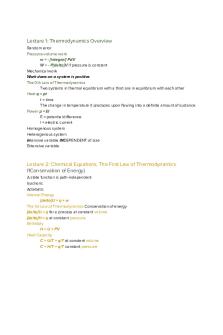
CHEM303 final exam review
- 4 Pages

Psychology Final Exam - Review
- 13 Pages
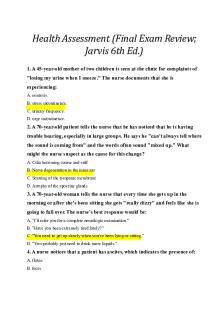
Jarvis Final Exam Review
- 12 Pages
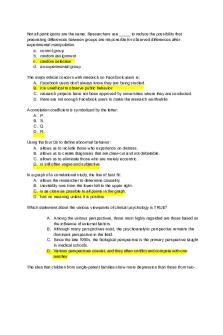
Final exam review
- 96 Pages
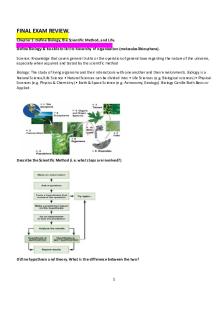
Final Exam Review
- 48 Pages
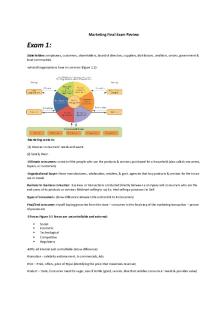
Marketing Final Exam Review
- 15 Pages
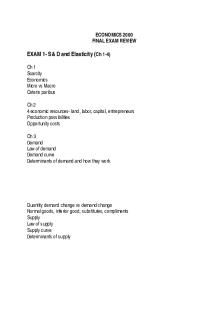
Final exam review
- 8 Pages
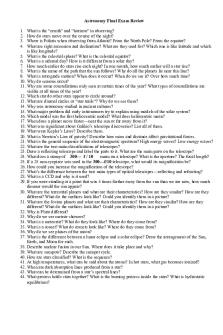
Astronomy Final Exam Review
- 2 Pages
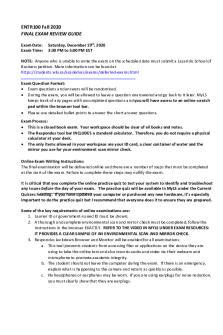
Final Exam Review Guide
- 4 Pages

Final exam review flsp4420
- 5 Pages

Theo Final Exam Review
- 16 Pages
Popular Institutions
- Tinajero National High School - Annex
- Politeknik Caltex Riau
- Yokohama City University
- SGT University
- University of Al-Qadisiyah
- Divine Word College of Vigan
- Techniek College Rotterdam
- Universidade de Santiago
- Universiti Teknologi MARA Cawangan Johor Kampus Pasir Gudang
- Poltekkes Kemenkes Yogyakarta
- Baguio City National High School
- Colegio san marcos
- preparatoria uno
- Centro de Bachillerato Tecnológico Industrial y de Servicios No. 107
- Dalian Maritime University
- Quang Trung Secondary School
- Colegio Tecnológico en Informática
- Corporación Regional de Educación Superior
- Grupo CEDVA
- Dar Al Uloom University
- Centro de Estudios Preuniversitarios de la Universidad Nacional de Ingeniería
- 上智大学
- Aakash International School, Nuna Majara
- San Felipe Neri Catholic School
- Kang Chiao International School - New Taipei City
- Misamis Occidental National High School
- Institución Educativa Escuela Normal Juan Ladrilleros
- Kolehiyo ng Pantukan
- Batanes State College
- Instituto Continental
- Sekolah Menengah Kejuruan Kesehatan Kaltara (Tarakan)
- Colegio de La Inmaculada Concepcion - Cebu